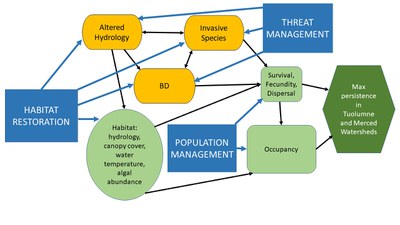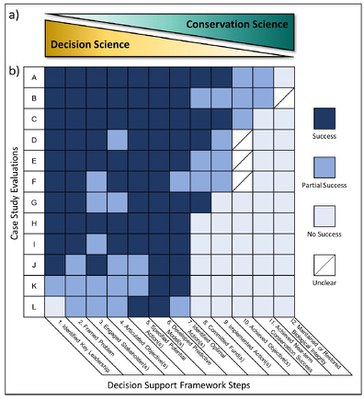Case Study
CA - Identifying Climate-Refugia for At-Risk Species
From Frog to Forest Conservation: Identifying Climate-Refugia for At-Risk Species in the Southern Sierra Nevada Forest

Conceptual Model for Foothill Yellow Legged Frog
Conceptual Model for Foothill Yellow Legged Frog – This logic model illustrates the mechanistic links between A. habitat quality (light green oval) and threats to the habitat (orange boxes); B. threats (orange boxes) to the population and population’s fecundity, survival, and dispersal (light green boxes); and C. fecundity, survival, dispersal, occupancy and the fundamental objective of maximizing the persistence of the populations in the Tuolumne and Merced watersheds. The blue boxes represent the categories of management actions to either reduce the threats to the habitat and populations or directly benefit the habitat or populations

12 case studies that used structured decision making
From Wright et al. 2020 [7] Analysis of 12 case studies that used structured decision making were assessed success across multiple stages from identifying leadership to identifying optimal actions all the way to implementation and the final desired outcome related to biological integrity. It is noteworthy that few of these case studies resulted in achieving their state objectives, let alone achieving the desired biological integrity. Often, these case studies were not successful in securing funding for implementation.
At Risk Species Conservation in the Pacific Southwest
USFWS
CASSC Proposal 2020
Frogs to Forest
AGU Poster 2020
From Frog to Forest Conservation: Identifying Climate-Refugia for At-Risk Species in the Southern Sierra Nevada Forest Poster – AGU 2020
Proposal - Toward climate change refugia conservation at an ecoregion scale in the Sierra Nevada
Proposal to the Climate Adaptation Science Center, USGS. ABSTRACT Climate change uncertainty poses serious challenges to conservation efforts. One emerging conservation strategy is to identify and conserve climate change refugia: areas relatively buffered from contemporary climate change that enable persistence of valued resources. This management paradigm may be pursued at broad scales by leveraging existing resources and placing them into a tangible framework to stimulate further collaboration that fosters management decision-making. Here, we describe a framework for moving toward operationalizing climate change refugia conservation at an ecoregion scale with a review for the Sierra Nevada (California, USA). Structured within the Climate Change Refugia Conservation Cycle, we identify a preliminary suite of conservation priorities for the ecoregion, and demonstrate how existing mapping, data, and applications can be used for identifying, prioritizing, managing, and monitoring refugia. We focus on six conservation priorities, including meadows, old growth forests, giant Sequoia, and alpine ecosystems, and introduce the concept of ecosystem process-based refugia, including snow and fire. This pilot overview of concepts and resources provides a foundation of ideas for both near-term implementation and further discussion in moving from science to conservation practice. Such an approach may provide new practical insights for ecosystem management at ecoregion scales in the face of climate change.
Supplement to Proposal (Balantic et al.)
from Proposal submitted to Climate Adaptation Science Center, USGS. Sampling of additional resources that could be leveraged for identifying and validating refugia in the Sierra Nevada ecoregion
2021 CA Prop 1 Restoration Grant Program
Solicitation
